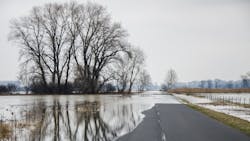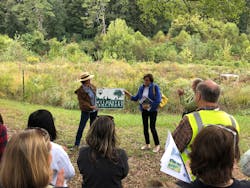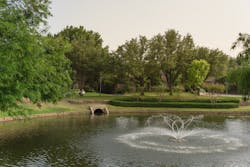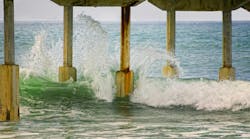Runoff from urban, suburban and agricultural land can carry excess nutrients, sediments and other pollutants into streams
lakes, and groundwater supplies degrading water quality. In fact, the United States Environmental Protection Agency (U.S. EPA) has cited urban stormwater as the largest contributor of pollutants to our waterways1. For municipal areas, U.S. EPA’s National Pollutant Discharge Elimination System (NPDES) Program requires communities to develop stormwater management programs and implement stormwater control measures to minimize the discharge of pollutants. These regulations are focused on water quality, but many communities across the country also suffer repeat flooding from riverine systems as well as undersized, antiquated storm sewer networks. Increased urbanization and climate change only make matters worse.
Understanding green infrastructure
Green stormwater infrastructure (GSI) is a stormwater management practice that mimics natural hydrologic processes. The benefits of GSI for water quality and runoff reduction are well known but one of the benefits that is not as widely recognized is mitigation of flood risk. Addressing resiliency to extreme wet weather events is a major concern in the United States. GSI can be an effective tool in providing water quality and stormwater runoff storage for small storms events as well as a method to reduce peak flows and capture runoff from major wet weather events.
U.S. EPA’s report “Flood Loss Avoidance Benefits of Green Infrastructure for Stormwater Management,” released in December 2015, was one of the first documents to estimate the poten- tial reduction in flood losses when GSI is applied on a watershed scale2. Since that time, a number of other articles have confirmed that GSI has the potential to be an effective tool in reducing peak discharges during storm events and reducing the impact of flooding events3.
Stormwater master planning and design projects are more frequently being conducted using nature- based solutions to reduce wet weather vulnerability risks. These projects often mitigate drainage issues for large storm events, even those up to the 100-year design event, by using green solutions to support traditional gray infrastructure. They often use hydro- logic and hydraulic models to evaluate the impact of GSI, collection and riverine system improvements at a range of scales to minimize flooding in addition to optimizing water quality. Finally, they are often evaluated more holisti- cally to not only improve water quality and quantity but provide a host of co-benefits that can spur economic development and improve quality of life for residents.
Using GSI to improve water quality
On the planning level, many communities are looking at ways to implement GSI as part of capital improvement programs to improve water quality while helping to mitigate flooding. By addressing water quality as part of major drainage capital improvement projects, communities can help meet their municipal separate storm sewer systems (MS4) regulatory requirements while address- ing flooding concerns. The days of single purpose public works projects are dwindling with integrated, multi-use projects becoming the new norm. Consideration during planning of involving partners to help fund and implement projects is also a growing trend, especially with greater value being placed on partnerships with various federal funding opportunities such as the Bipartisan Infrastructure Law.
The Greater Chicago Watershed Alliance (GCWA), a large group of Chicago area watershed partners, is a great example of how public and non-profit agencies across a region can engage with each other during the planning stages of projects to identify ways to collaborate and provide benefit on both a local and regional scale. Friends of the Chicago River, supported by GCWA, commissioned development of a Natural Solutions Tool to identify optimum areas for GSI within the Chicagoland area and promote expanded investments in nature-based solutions4. The tool provides an interactive map portal to search on specific parcels or areas for important criteria such as “green infrastructure considerations” as well as static maps that provide overall analysis results for the following social themes: healthy, equitable, biodiverse, protected and connected. A user guide and data description document with detailed information about each of the data layers are also provided. The tool is publicly available on the following website: https://web.tplgis.org/chicago_nst/.
The goal for use of the tool is to promote consideration of nature-based solutions on capital improvement projects that address flood mitigation and maximize use of funds that can provide the greatest benefit to the area’s residents.
There have also been many new design innovations to improve the water quality of urban stormwater runoff. Outfalls in MS4 communities are the last line of defense before stormwater is discharged and these sensitive areas are often hotspots for severe erosion, especially with increased flows due to urbanization and climate change. Consequently, outfall retrofit projects can be implemented in small footprints in response to uncontrolled runoff from upstream development, inadequate energy dissipation, and poor slope stabilization. From straight-forward riprap plunge pools to intricate step pool systems, there is a wide array of methods to be considered when restoring an eroded outfall.
Chesterfield County in Virginia has taken the proactive approach to achieve two separate but important program goals of improving water quality and repairing degraded outfalls. They achieved these goals by implementing outfall retrofit projects at public facilities throughout the county such as schools and municipal facilities. They targeted sites which were originally constructed without any stormwater management facilities, had large impervious areas which were untreated, and had outfalls that were degrading. One of these projects included the implementation of a Regenerative Stormwater Conveyance (RSC) system at an outfall from the County’s Government Complex.
This best management practice restores eroded outfalls by removing sediment through a series of pools and riffles with woodchip stream beds that filter pollutants and promote infiltration of stormwater during small storm events, while being designed to safely convey flows in a non- erosive manner. With any large-scale drainage improvement project, the public should be engaged early and often to foster community support and ensure improvements are addressing local needs. In addition to addressing water quality and/or quantity concerns, opportunities for providing holistic solutions that include local amenities that improve the livability of residents should also be considered where feasible.
Reducing runoff
An example of the benefits of runoff reduction using GSI in a highly urbanized watershed is the McDaniel Branch project in Atlanta5. The project site, the former location of an early public housing project, had been abandoned and overgrown and provided very little community value. The stormwater improvement project, part of the city’s overall watershed improvement program, was seen by the city to demonstrate the possibilities of urban watershed restoration — to address flooding and water quality but also improve community resilience and address equity. This project includes approximately 1,100 linear feet of stream restoration, rerouting of several storm sewers that discharged directly into McDaniel Branch into a series of ponds and constructed wetlands.
These best management practices capture stormwater runoff from the areas sur- rounding the site and also divert part of the first flush from an existing 66-inch storm sewer that drains the upstream portion of the drainage basin. The development of a site management plan following construction that addresses the wetland and upland meadows, ponds, invasive species control, mosquitoes, wildlife including geese and beaver, and public access, has resulted in this area now having diverse vegetation and aquatic life that has attracted wildlife that could not otherwise be conceived in a dense urban setting.
Where the project site was once an eyesore and local nuisance, it has been transformed into a destination location that is now visited by residents and wildlife enthusiasts alike and has been designated a Wildlife Sanctuary by the Atlanta Audubon Society.
With the dramatic increase in intensity of storm events in recent decades due to climate change, addressing resiliency to extreme wet weather events is a major concern. GSI can be an effective tool in reducing peak flows and capturing runoff from major wet weather eventsin addition to providing water quality and stormwater runoff storage for small storms events. It can also be part of a holistic solution that provides an amenity to the community and improves the livability of residents.
References
1. U.S. Environmental Protection Agency, National Water Quality Inventory Report to Congress, https://www.epa.gov/waterdata/national-water- quality-inventory-report-congress, 2022
2. U.S. Environmental Protection Agency, Flood Loss Avoidance Benefits of Green Infrastructure for Stormwater Management, December 2015
3. Maragno et al, Fine-scale analysis of urban flooding reduction from green infrastructure: An ecosystem services approach for the management of water flows, Elsevier, 2018
4. Trust for Public Land, Natural Solutions Tool, Greater Chicago, A Watershed Approach, https://web.tplgis.org/chicago_nst/, 2023
5. Anwer Ahmed, PE, DWRE & Susan Rutherford, Enhance Biodiversity, Community Resilience, and Water Quality Benefits through Effective Stormwater Wetland Management,
WEFTEC, 2021








